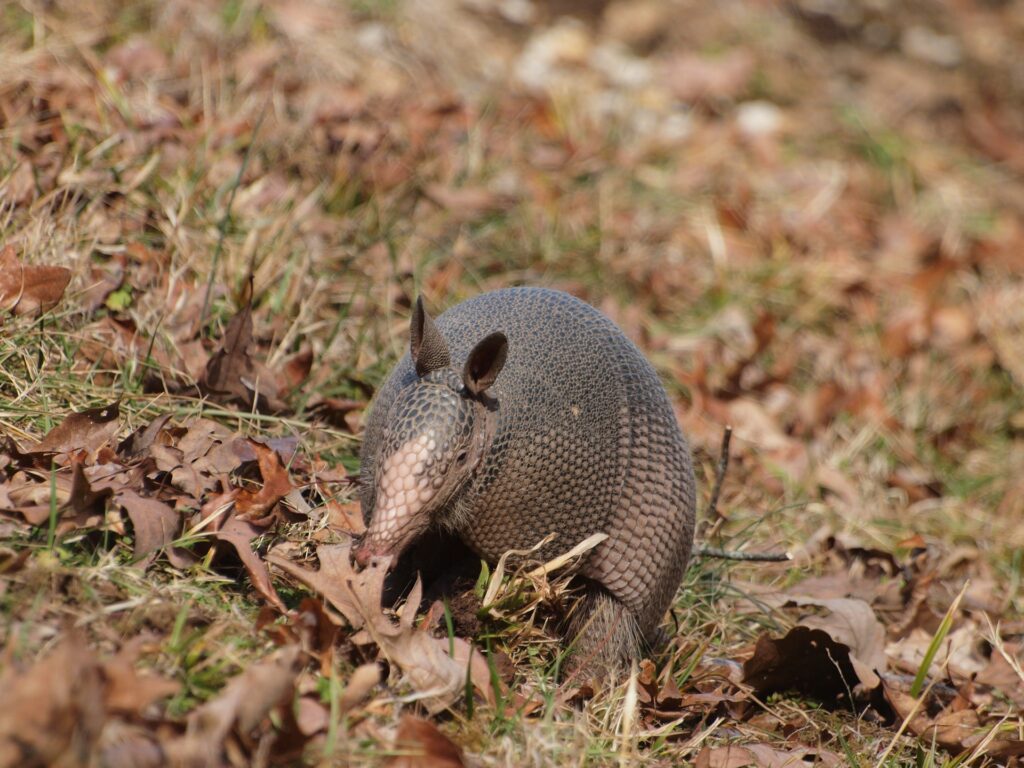Armadillos were first spotted in North Carolina in 2007. Now there have been confirmed observations in twenty-five counties including Wake County. Over forty counties have credible observations or unconfirmed reports of armadillos.
Armadillos present little danger to people. The greatest danger they pose is to your landscaping. Controlling the animal can protect your lawn and garden and the integrity of structures like decks and driveways on your property.

Armadillo Control

Armadillo Trapping
Armadillo control plans involve removing current residents by trapping. The traps should be set overnight to capture an armadillo while it’s active. After all the armadillos are removed from your property, it’s time to implement exclusion strategies.

Exclusion
One effective solution is to build a fence that goes a few feet into the ground. Without an easy entry point to your property, future armadillos will likely find a different place to forage. If fencing your entire property is cost-prohibitive, building a fence around highly valued areas is an option. For example, you could construct a fence around your garden that provides protection from armadillos.

Prevention
Armadillos do very little damage to your home. In addition to exclusion devices, habitat modification can keep armadillos away from your yard. Wood chips can deter an armadillo from burrowing. Water your soil early in the morning can make it difficult for an armadillo to dig at night.
Armadillo in your yard
An armadillo has no need to make its way into your home. But the food sources around your home will draw it onto your property.
Luckily, an armadillo has a very distinct appearance. So, if you spot the critter, you’ll know exactly what it is. But the nocturnal nature of these animals means that your paths may never collide.
During daylight hours, it’s possible to see the evidence of an armadillo’s nighttime feeding. You’ll see small holes around the yard, destroyed garden beds, and possibly a deeper hole that serves as a burrow.
Signs of Armadillo Infestation
Their intolerance for cold means armadillos can live in the piedmont of North Carolina. The nocturnal creatures will amble onto your property at night in search of grubs and insects. While they forage through your yard, they leave a trail of destruction in their wake. The destruction takes the form of small holes.
As an armadillo hunts for its next insect, it makes a small hole around 1 to 3 inches deep and 3 to 5 inches wide. The sheer number of these holes is a nuisance for anyone walking around your property.
Beyond the inconvenience of these holes, the digging can lead to damage to driveways and sidewalks. And in severe infestations, the structural integrity of your home’s foundation might be at risk!
Problems with Armadillos
Armadillo Lawn Damage
Beyond carrying a risk of diseases onto your property, armadillos can cause significant damage with their digging habits. The small holes left around your property present a real tripping hazard. Plus, these foraging holes can decimate a treasured garden.
In addition to foraging holes, armadillos build large burrows. Although the opening is just 8 inches wide, the tunnel can extend up to 15 feet into the ground. Depending on the location of the burrow, it could cause major damage to your home’s foundation.
Health Hazards
Armadillos are not aggressive towards humans. Typically, they’ll go about their own business if they encounter a human. But it’s important to steer clear because they carry Hansen’s disease, otherwise known as leprosy. Other than humans, armadillos are the only known species susceptible to leprosy. These animals also carry other types of infectious diseases that pose a risk to your health.Call Trutech IN
At Trutech, we have the expertise to handle any nuisance wildlife problem you may have.

Our professional team of licensed technicians will quickly and humanely handle your wildlife needs
Quick Links
Business Hours
- Monday-Friday: 7:30am-6pm
- Saturday: 9am-5pm
- Sunday: Closed
